DIW-Printed Thermal Management PDMS Composites with 3D Structural Thermal Conductive Network of h-BN Platelets and Al2O3 Nanoparticles
Abstract
1. Introduction
2. Materials and Methods
2.1. Materials
2.2. Synthesis of BN/Al2O3/PDMS
2.3. Characterization
3. Results and Discussion
3.1. The Rheological Behavior during DIW Printing
3.2. Analysis of the Printing Quality of DIW Parts
3.3. Microscopic Morphology of Composite Parts
3.4. BN Orientation Analysis of Composites
3.5. Thermal Conductivity of Composite Materials
3.6. Electrical Insulation Properties of Composites
3.7. Mechanical Properties of Composite Materials
4. Conclusions
Author Contributions
Funding
Institutional Review Board Statement
Informed Consent Statement
Data Availability Statement
Conflicts of Interest
References
- Chen, C.; Yu, H.-T.; Feng, Y.-Y.; Feng, W. Polymer Composite Material with both Thermal Conduction and Self-healing Functions. Acta Polym. Sin. 2021, 52, 272–280. [Google Scholar]
- Cho, E.-C.; Chang-Jian, C.-W.; Hsiao, Y.-S.; Lee, K.-C.; Huang, J.-H. Three-dimensional carbon nanotube based polymer composites for thermal management. Compos. Part A Appl. Sci. Manuf. 2016, 90, 678–686. [Google Scholar] [CrossRef]
- Fang, H.; Chen, A.; Zhang, L.; Chen, S.; Wu, F.; Chen, H. Synergistic enhancement of thermal conductivity in thermal interface materials by fabricating 3D-BN-ZnO scaffolds. Polym. Eng. Sci. 2022, 62, 1641–1649. [Google Scholar] [CrossRef]
- Fang, H.; Zhang, X.; Zhao, Y.; Bai, S.-L. Dense graphene foam and hexagonal boron nitride filled PDMS composites with high thermal conductivity and breakdown strength. Compos. Sci. Technol. 2017, 152, 243–253. [Google Scholar] [CrossRef]
- Fu, H.; Huang, Y.; Liu, Y.; Li, F.; Gai, Z.; Jiang, Y.; Gao, X.; Zhuang, J.; Sun, J.; Xu, H.; et al. Enhanced thermal conduction of hybrid filler/polydimethylsiloxane composites via a continuous spatial confining process. Compos. Sci. Technol. 2022, 226, 109536. [Google Scholar] [CrossRef]
- He, X.; Wang, Y. Synergistic effects on the enhancement of thermal conductive properties of thermal greases. J. Appl. Polym. Sci. 2019, 136, 47726. [Google Scholar] [CrossRef]
- Hou, X.; Zhang, Z.; Wei, X.; Qin, Y.; Song, G.; Li, L.; Li, M.; Dai, W.; Zhao, S.; Lin, C.-T.; et al. Aluminum Borate/Boron Nitride Nanosheet Fibers for Enhancing the Thermal Conductivity of Polymer Composites. ACS Appl. Nano Mater. 2021, 4, 2136–2142. [Google Scholar] [CrossRef]
- Lin, Q.-h.; He, S.; Liu, Q.-q.; Yang, J.-h.; Qi, X.-d.; Wang, Y. Construction of a 3D interconnected boron nitride nanosheets in a PDMS matrix for high thermal conductivity and high deformability. Compos. Sci. Technol. 2022, 226, 109528. [Google Scholar] [CrossRef]
- Eom, K.H.; Baek, S.; Kim, I. N-Heterocyclic Carbene-Catalyzed Random Copolymerization of N-Carboxyanhydrides of α-Amino Acids. Polymers 2021, 13, 3674. [Google Scholar] [CrossRef] [PubMed]
- Fang, H.; Li, G.; Wang, K.; Wu, F. Significant Improvement of Thermal Conductivity of Polyamide 6/Boron Nitride Composites by Adding a Small Amount of Stearic Acid. Polymers 2023, 15, 1887. [Google Scholar] [CrossRef]
- Huang, Z.; Wu, W.; Drummer, D.; Liu, C.; Wang, Y.; Wang, Z. Enhanced the Thermal Conductivity of Polydimethylsiloxane via a Three-Dimensional Hybrid Boron Nitride@Silver Nanowires Thermal Network Filler. Polymers 2021, 13, 248. [Google Scholar] [CrossRef] [PubMed]
- Hutchinson, J.M.; Roman, F.; Folch, A. Epoxy-Thiol Systems Filled with Boron Nitride for High Thermal Conductivity Applications. Polymers 2018, 10, 340. [Google Scholar] [CrossRef] [PubMed]
- Lei, C.; Zhang, Y.; Liu, D.; Xu, X.; Wu, K.; Fu, Q. Highly thermo-conductive yet electrically insulating material with perpendicularly engineered assembly of boron nitride nanosheets. Compos. Sci. Technol. 2021, 214, 108995. [Google Scholar] [CrossRef]
- Li, X.; Yang, L.; Chen, X.; Jiang, F. Construction of compressible dual thermally conductive boron nitride network supported by Polyurethane@Polydopamine skeleton for improved thermal management performance. Compos. Part A Appl. Sci. Manuf. 2022, 161, 107104. [Google Scholar] [CrossRef]
- Liang, X.; Chen, W.; Ji, J.; Liu, M.; Li, J.; Gan, L.; He, Y.; Li, B.; Kang, F.; Du, H. Synergistic effect of carbon fiber and alumina in improving the thermal conductivity of polydimethylsiloxane composite. Thermochim. Acta 2021, 703, 178980. [Google Scholar] [CrossRef]
- Lin, Y.-S.; Hsu, S.L.-C.; Ho, T.-H.; Jheng, L.-C.; Hsiao, Y.-H. Preparation and Thermomechanical Properties of Ketone Mesogenic Liquid Crystalline Epoxy Resin Composites with Functionalized Boron Nitride. Polymers 2020, 12, 1913. [Google Scholar] [CrossRef]
- Moradi, S.; Calventus, Y.; Roman, F.; Hutchinson, J.M. Achieving High Thermal Conductivity in Epoxy Composites: Effect of Boron Nitride Particle Size and Matrix-Filler Interface. Polymers 2019, 11, 1156. [Google Scholar] [CrossRef] [PubMed]
- Tang, B.; Cao, M.; Yang, Y.; Guan, J.; Yao, Y.; Yi, J.; Dong, J.; Wang, T.; Wang, L. Synthesis of KH550-Modified Hexagonal Boron Nitride Nanofillers for Improving Thermal Conductivity of Epoxy Nanocomposites. Polymers 2023, 15, 1415. [Google Scholar] [CrossRef] [PubMed]
- Wang, Y.; Wu, W.; Drummer, D.; Liu, C.; Tomiak, F.; Schneider, K.; Huang, Z. Achieving a 3D Thermally Conductive while Electrically Insulating Network in Polybenzoxazine with a Novel Hybrid Filler Composed of Boron Nitride and Carbon Nanotubes. Polymers 2020, 12, 2331. [Google Scholar] [CrossRef] [PubMed]
- Tu, L.; Xiao, Q.; Wei, R.; Liu, X. Fabrication and Enhanced Thermal Conductivity of Boron Nitride and Polyarylene Ether Nitrile Hybrids. Polymers 2019, 11, 1340. [Google Scholar] [CrossRef] [PubMed]
- Elahee, G.M.F.; Cheng, X.; Rong, L.; Xu, M.-W.; Souza, L.; Advincula, R.C.; Maia, J. On the cogent formulation of an elastomeric silicone ink material for direct ink write (DIW) 3D printing. Polym. Eng. Sci. 2024. ahead of print. [Google Scholar] [CrossRef]
- Nocheseda, C.J.C.; Elahee, G.M.F.; Santos, M.F.A.; Cheng, X.; Espera Jr, A.H.; Advincula, R.C.C. On the 3D printability of one-part moisture-curable polyurethanes via direct ink writing (DIW). Mrs Commun. 2023, 13, 647–656. [Google Scholar] [CrossRef]
- Saadi, M.A.S.R.; Maguire, A.; Pottackal, N.T.; Thakur, M.S.H.; Ikram, M.M.; Hart, A.J.; Ajayan, P.M.; Rahman, M.M. Direct Ink Writing: A 3D Printing Technology for Diverse Materials. Adv. Mater. 2022, 34, 2108855. [Google Scholar] [CrossRef] [PubMed]
- Elahee, G.M.F.; Rong, L.H.; Breting, C.; Bonilla-Cruz, J.; Ceniceros, T.E.L.; Smith, Z.J.; Ge, J.; Cheng, X.; Xu, M.W.; Yang, M.; et al. Acrylic sealants as practicable direct ink writing (DIW) 3D-printable materials. Mrs Commun. 2023, 13, 299–305. [Google Scholar] [CrossRef]
- Hu, L.; Evans, W.; Keblinski, P. Thermal Transport in Self-Assembled Conductive Networks for Thermal Interface Materials. J. Electron. Packag. 2011, 133, 4003865. [Google Scholar] [CrossRef]
- Xu, Z.; Bai, L.; Zhang, Y.; Cao, J.; Zheng, J. Mechanically strong, reprocessable and thermally stable PDMS/Hexagonal boron nitride composites with desirable thermal conductivities based on dynamic silyl ether linkages. Compos. Sci. Technol. 2023, 240, 110076. [Google Scholar] [CrossRef]
- Salvi, S.S.; Jain, A. Measurement of thermal conductivity of millimeter-sized wires using the fin effect. Appl. Therm. Eng. 2020, 178, 115482. [Google Scholar] [CrossRef]
- ISO/CD 22007-2; Plastics—Determination of Thermal Conductivity and Thermal Diffusivity—Part 2: Transient Plane Heat Source (Hot Disc) Method. ISO: Geneva, Switzerland, 2024.
- Mendonca, F.; Hu, J. Impact of Chemical Admixtures on Time-Dependent Workability and Rheological Properties of Ultra-High-Performance Concrete. Aci Mater. J. 2021, 118, 383–394. [Google Scholar] [CrossRef]
- Evans, W.; Prasher, R.; Fish, J.; Meakin, P.; Phelan, P.; Keblinski, P. Effect of aggregation and interfacial thermal resistance on thermal conductivity of nanocomposites and colloidal nanofluids. Int. J. Heat Mass Transf. 2008, 51, 1431–1438. [Google Scholar] [CrossRef]
- King, J.A.; Johnson, B.A.; Via, M.D.; Ciarkowski, C.J. Effects of Carbon Fillers in Thermally Conductive Polypropylene Based Resins. Polym. Compos. 2010, 31, 497–506. [Google Scholar] [CrossRef]
- Yang, W.; Zhan, Y.Q.; Feng, Q.Y.; Sun, A.; Dong, H.Y. Flexible h-BN/fluorinated poly (arylene ether nitrile) fibrous composite film with low dielectric constant and high thermal conductivity fabricated via coaxial electrospinning hot-pressing technique. Colloids Surf. A Physicochem. Eng. Asp. 2022, 649, 129455. [Google Scholar] [CrossRef]
- Wu, W.F.; Ren, T.L.; Liu, X.Q.; Davis, R.; Huai, K.; Cui, X.; Wei, H.X.; Hu, J.J.; Xia, Y.M.; Huang, S.H.; et al. Creating thermal conductive pathways in polymer matrix by directional assembly of synergistic fillers assisted by electric fields. Compos. Commun. 2022, 35, 101309. [Google Scholar] [CrossRef]
- Luo, T.F.; Esfarjani, K.; Shiomi, J.; Henry, A.; Chen, G. Molecular dynamics simulation of thermal energy transport in polydimethylsiloxane (PDMS). J. Appl. Phys. 2011, 109, 074321. [Google Scholar] [CrossRef]
- Yang, H.B.; Zheng, H.J.; Duan, Y.X.; Xu, T.; Xie, H.X.; Du, H.S.; Si, C.L. Nanocellulose-graphene composites: Preparation and applications in flexible electronics. Int. J. Biol. Macromol. 2023, 253, 126903. [Google Scholar] [CrossRef] [PubMed]


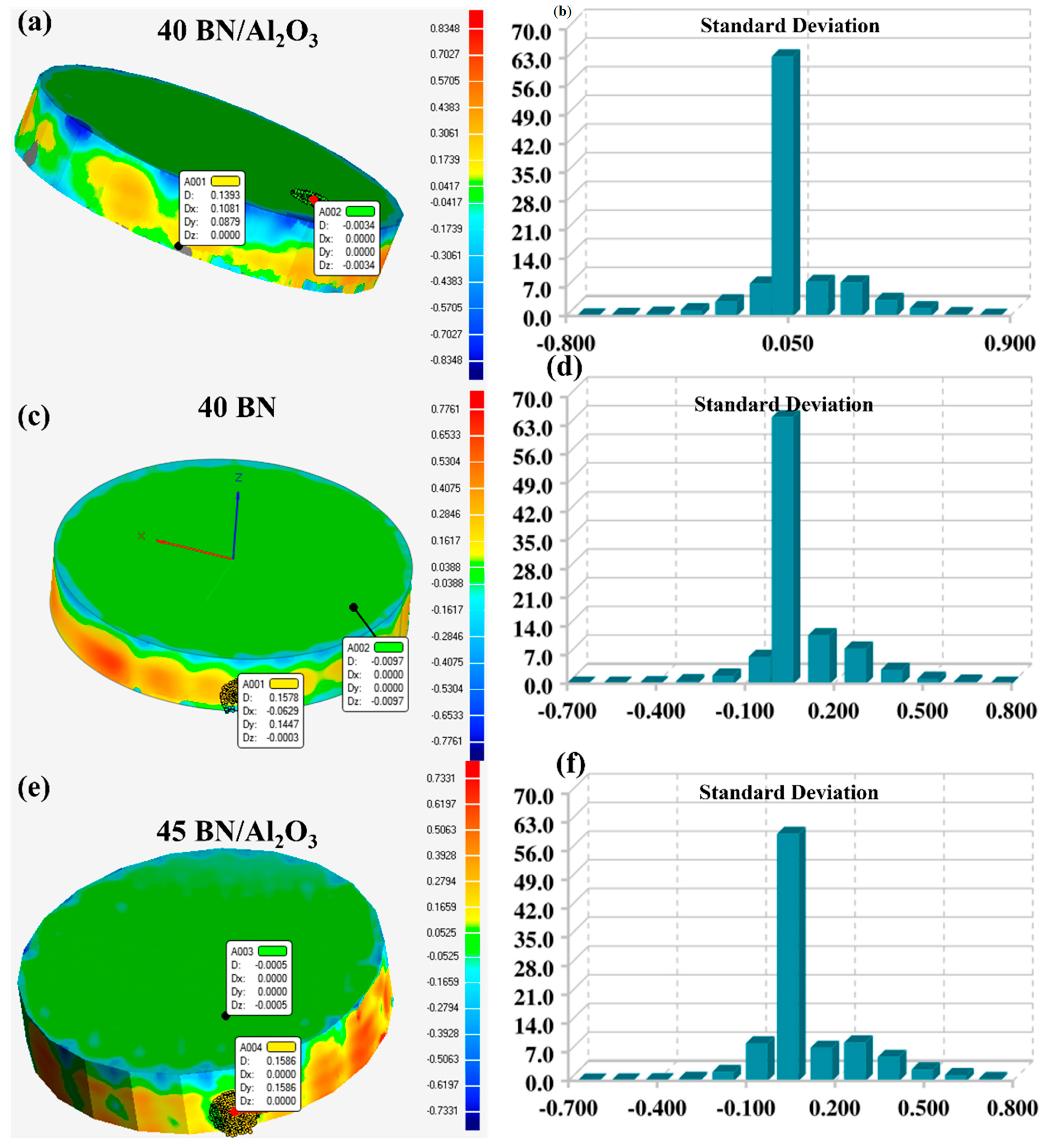
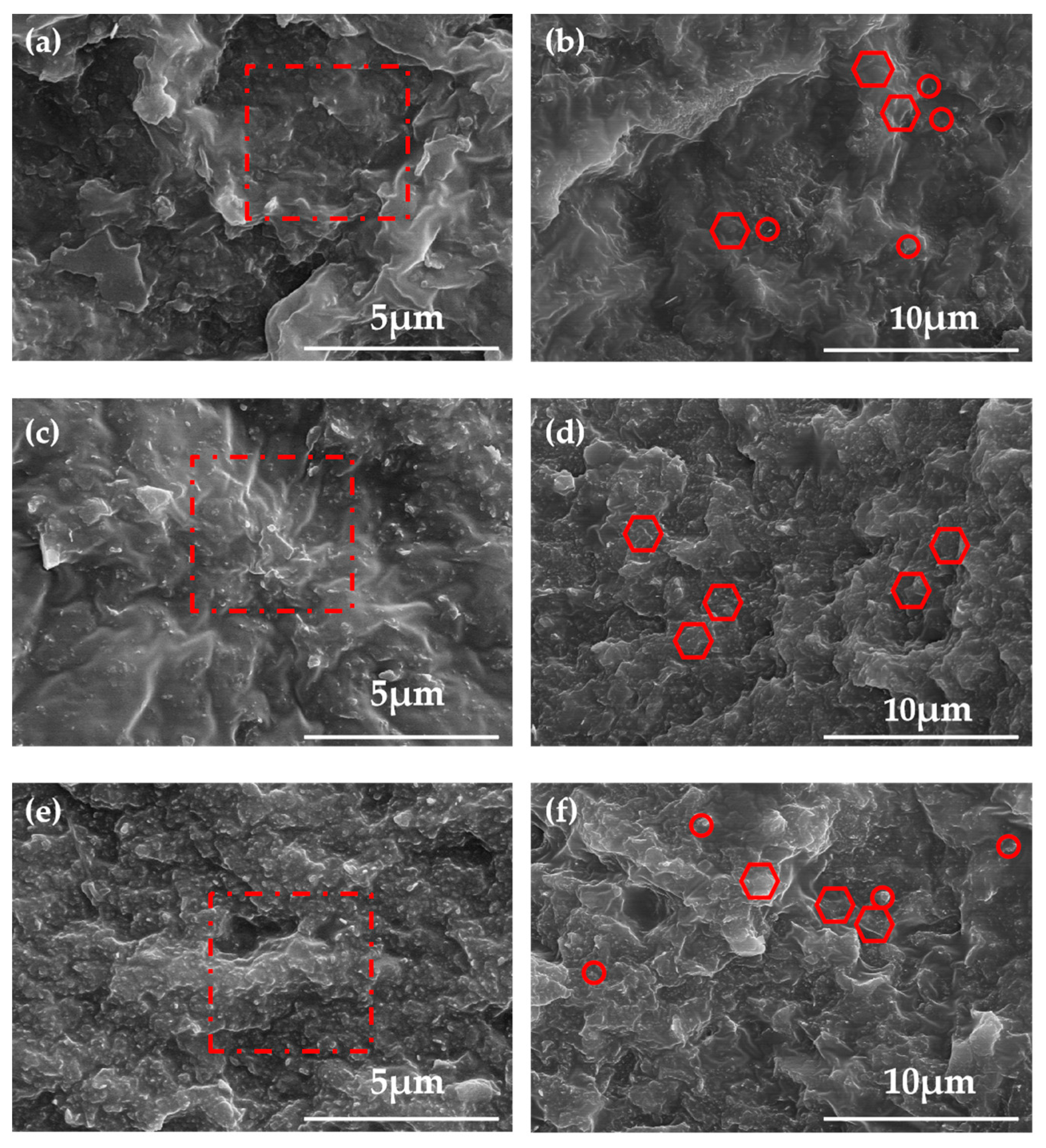

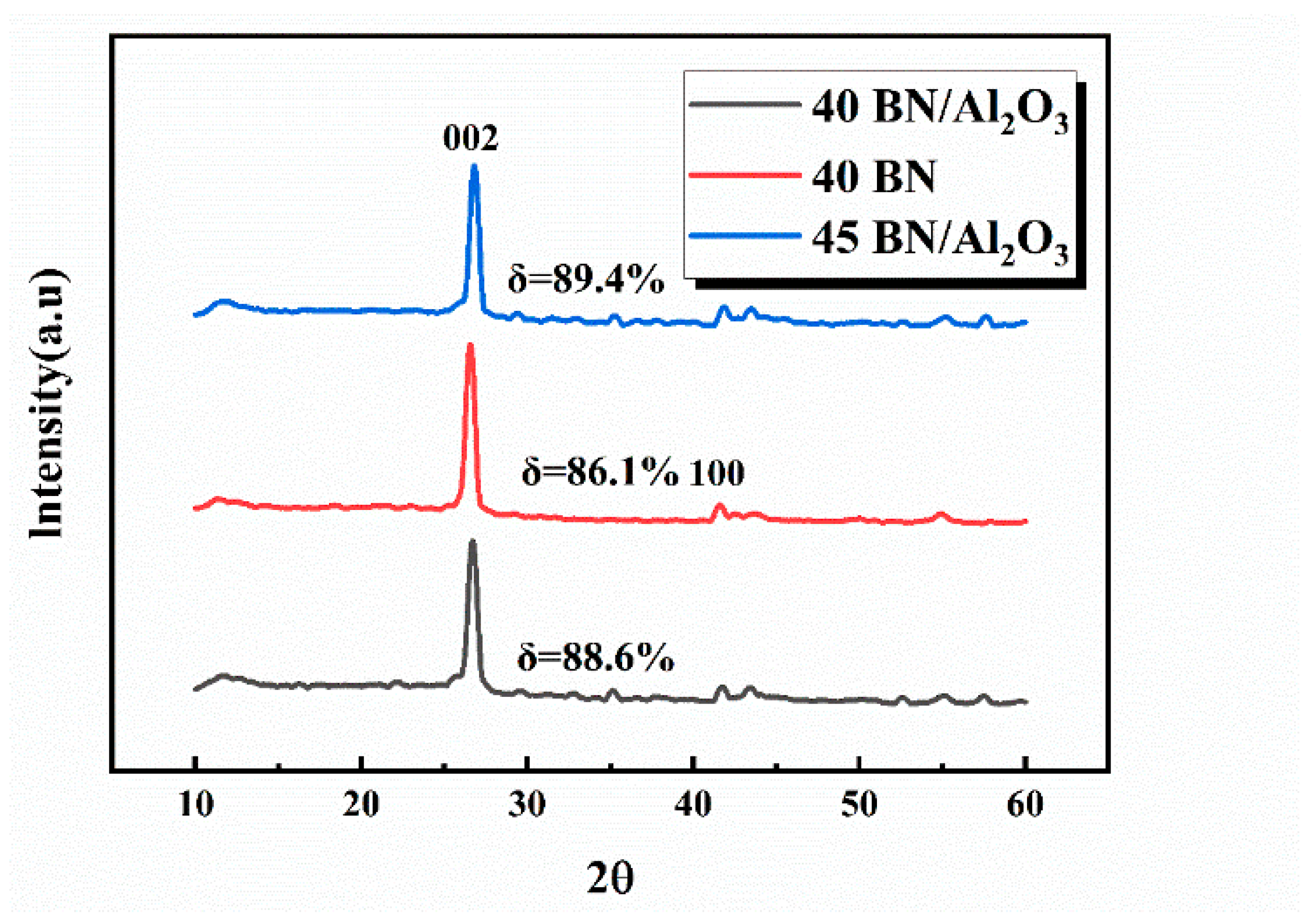
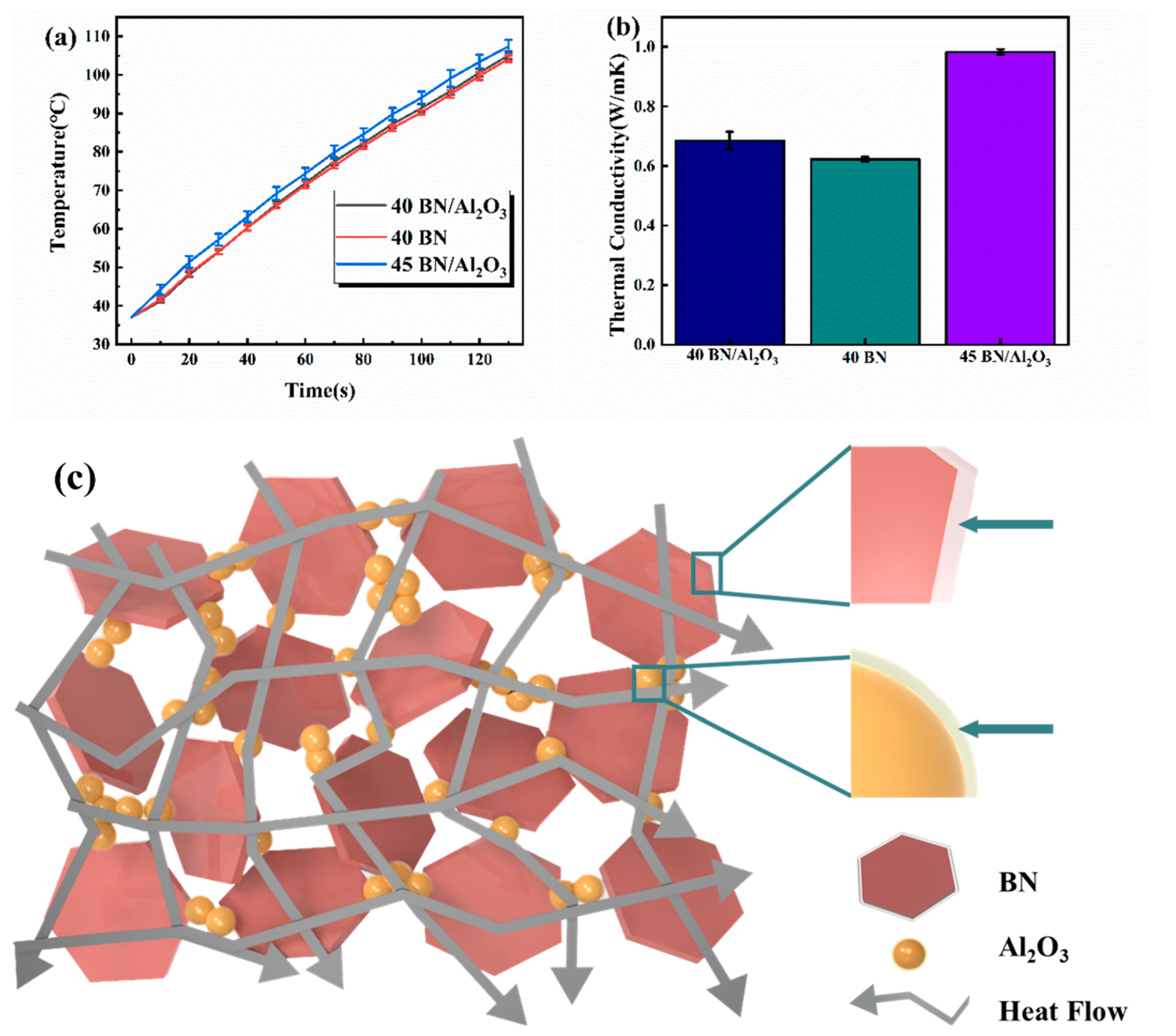

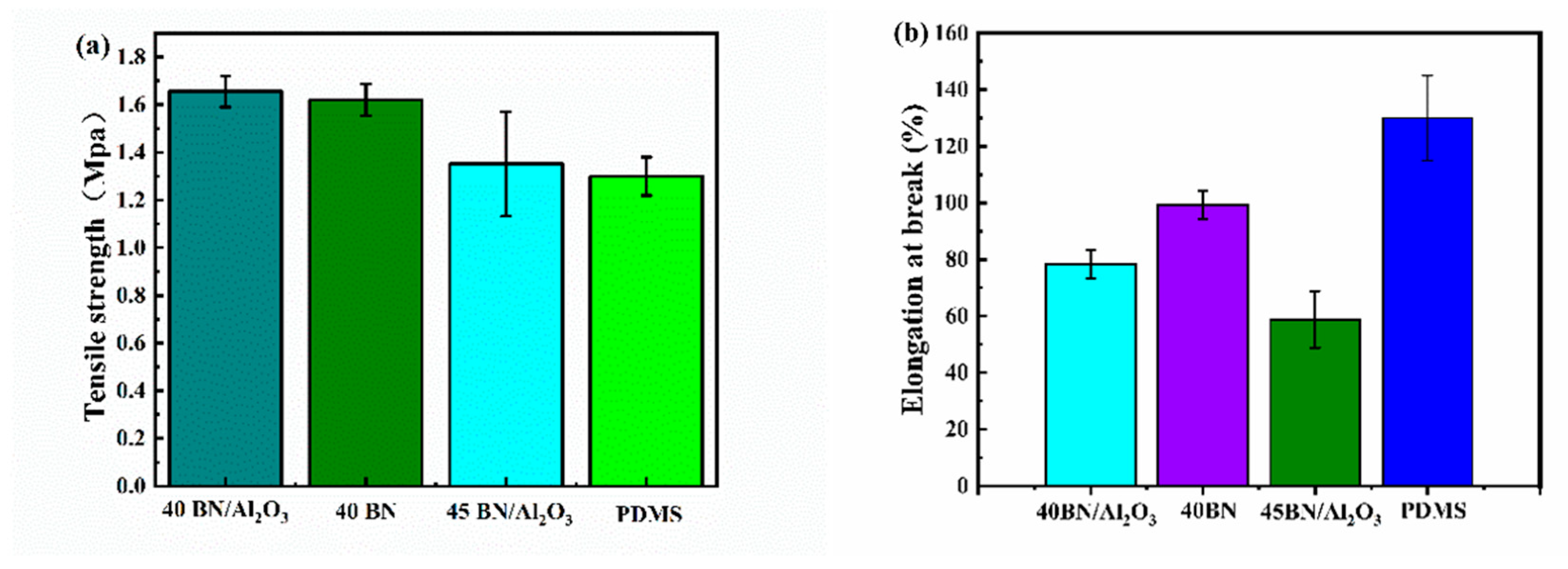
| Al2O3/wt% | BN/wt% | PDMS Precursor/wt% | Curing Agent/wt% | |
|---|---|---|---|---|
| 40 BN/Al2O3 | 8.00 | 32.0 | 54.0 | 6.00 |
| 40 BN | 0.00 | 40.0 | 54.0 | 6.00 |
| 45 BN/Al2O3 | 8.00 | 37.0 | 50.0 | 5.00 |
Disclaimer/Publisher’s Note: The statements, opinions and data contained in all publications are solely those of the individual author(s) and contributor(s) and not of MDPI and/or the editor(s). MDPI and/or the editor(s) disclaim responsibility for any injury to people or property resulting from any ideas, methods, instructions or products referred to in the content. |
© 2024 by the authors. Licensee MDPI, Basel, Switzerland. This article is an open access article distributed under the terms and conditions of the Creative Commons Attribution (CC BY) license (https://creativecommons.org/licenses/by/4.0/).
Share and Cite
Zhu, H.; Wu, S.; Tang, R.; Li, Y.; Chen, G.; Huang, B.; Peng, B. DIW-Printed Thermal Management PDMS Composites with 3D Structural Thermal Conductive Network of h-BN Platelets and Al2O3 Nanoparticles. Polymers 2024, 16, 1491. https://doi.org/10.3390/polym16111491
Zhu H, Wu S, Tang R, Li Y, Chen G, Huang B, Peng B. DIW-Printed Thermal Management PDMS Composites with 3D Structural Thermal Conductive Network of h-BN Platelets and Al2O3 Nanoparticles. Polymers. 2024; 16(11):1491. https://doi.org/10.3390/polym16111491
Chicago/Turabian StyleZhu, Hongyi, Shunxia Wu, Rui Tang, Yang Li, Gang Chen, Bingxue Huang, and Biyou Peng. 2024. "DIW-Printed Thermal Management PDMS Composites with 3D Structural Thermal Conductive Network of h-BN Platelets and Al2O3 Nanoparticles" Polymers 16, no. 11: 1491. https://doi.org/10.3390/polym16111491
APA StyleZhu, H., Wu, S., Tang, R., Li, Y., Chen, G., Huang, B., & Peng, B. (2024). DIW-Printed Thermal Management PDMS Composites with 3D Structural Thermal Conductive Network of h-BN Platelets and Al2O3 Nanoparticles. Polymers, 16(11), 1491. https://doi.org/10.3390/polym16111491








